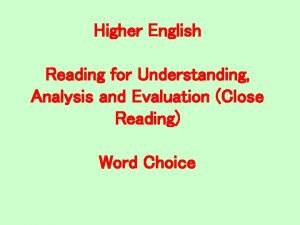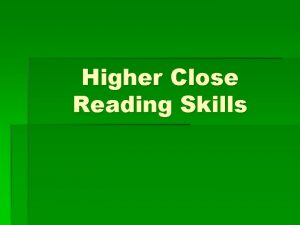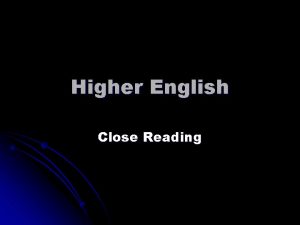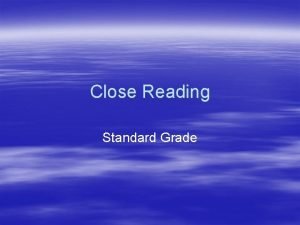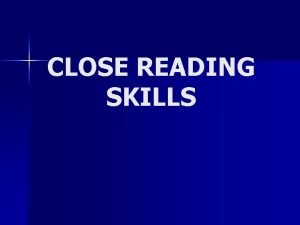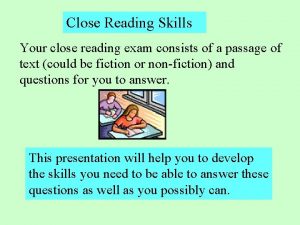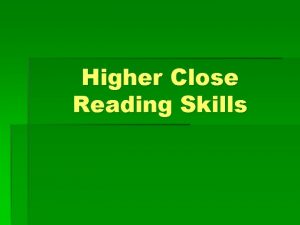Higher Close Reading Skills Section A UNDERSTANDING THE












- Slides: 12

Higher Close Reading Skills

Section A: UNDERSTANDING THE MEANING § 1) Using your own words § 2) Context questions § 3) Link questions

1) USING YOUR OWN WORDS

USING YOUR OWN WORDS § Some interpretation questions, like the example below from a recent Higher English examination paper, are designed to test whether you understand the basic meaning of the passage. § Question: Paragraphs 5, 6 and 7 deal with the “issues” referred to in line 69. In your own words, describe clearly what the three main issues are. § 6 marks

USING YOUR OWN WORDS § You will be asked to gather pieces of information which you must answer as far as possible in your own words. § Simple words from the original passage may be used if there is no obvious alternative, but where there is an obvious alternative you should use one. § Figures of speech in the original must always be put into plain language, and any non-standard expression, for example slang or archaisms (old-fashioned words), must be rendered in simple, formal, modern English. § * Warning!!!! It is essential that you do not “lift” whole phrases or sentences from the original: these will not be awarded any marks, even though you have understood the question and the answer is correct.

WHAT THE EXAMINER IS LOOKING FOR

WHAT THE EXAMINER IS LOOKING FOR § How much should you write? Every exam paper has what is called a “marking scheme”: the number of marks which are allocated to each question. § A marker cannot give you any more than the number allotted, and he will look for the required amount of information before awarding full marks to a question.

Steps you should take § Before you write your answer, you must take note of the number of marks available. For two marks, it is likely you will need to supply two pieces of information, but alternatively you might be required to give one detailed piece or four brief pieces. § It will be necessary for you to consider the wording of the question carefully for guidance. Occasionally, direct guidance may not be given and in this case you must use your common sense. § Obviously, one brief piece of information will be inadequate for a four mark question; conversely, providing a ten line answer for a one mark question is unwise as you will waste valuable time.

Look at the following example.

§ ‘Thinking of Grandpa now, I recall the clouds of pungent smoke that he puffed from his favourite briar, his small shrewd eyes, still very blue, and the gleaming dome rising from fleecy tufts of white hair. ’ § Question: What three characteristics of “Grandpa” does the author remember? § 3 marks § Answer: She remembers her grandfather smoked a strong-smelling pipe. He also had intelligent bright blue eyes and a bald head with a little fluffy white hair.

Method: § Understanding of “briar” is shown by using the more general term “pipe”. The metaphor “gleaming dome” is simplified to “bald head”. § Since the word “eyes” is a common word with no obvious alternatives it may be used again. § There are several possible alternative words for “shrewd”, and “intelligent” is an acceptable one. Since “grandpa” is colloquial, the more formal “grandfather” is used in the answer. § If the question were worth only 1 or 1 1/2 marks, it could be answered more briefly: Her grandfather smoked a pipe, he had blue eyes, and was very bald.

FOR PRACTICE
 Higher english close reading
Higher english close reading Higher close reading
Higher close reading Higher english close reading
Higher english close reading While reading activities
While reading activities Understanding standards media
Understanding standards media Advanced higher geography study
Advanced higher geography study Higher art understanding standards
Higher art understanding standards Advanced higher computing understanding standards
Advanced higher computing understanding standards Understanding standards advanced higher english
Understanding standards advanced higher english Advanced higher english understanding standards
Advanced higher english understanding standards Higher modern studies understanding standards
Higher modern studies understanding standards Understanding standards advanced higher english
Understanding standards advanced higher english Understanding standards higher art
Understanding standards higher art
